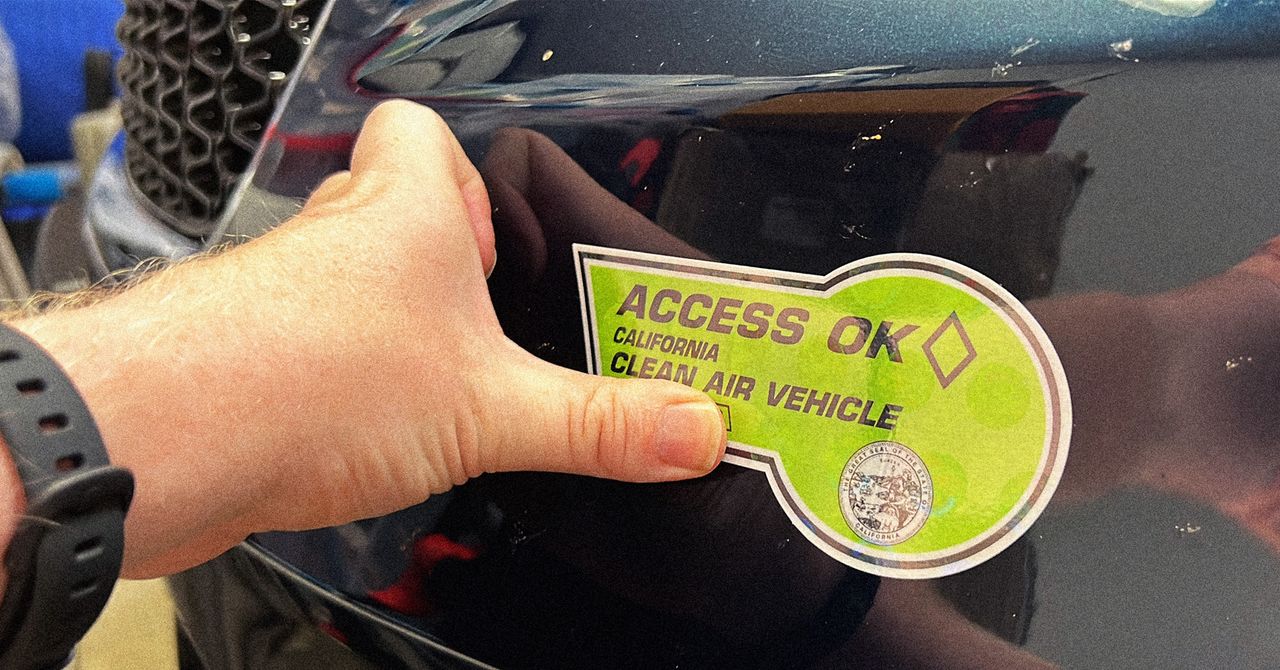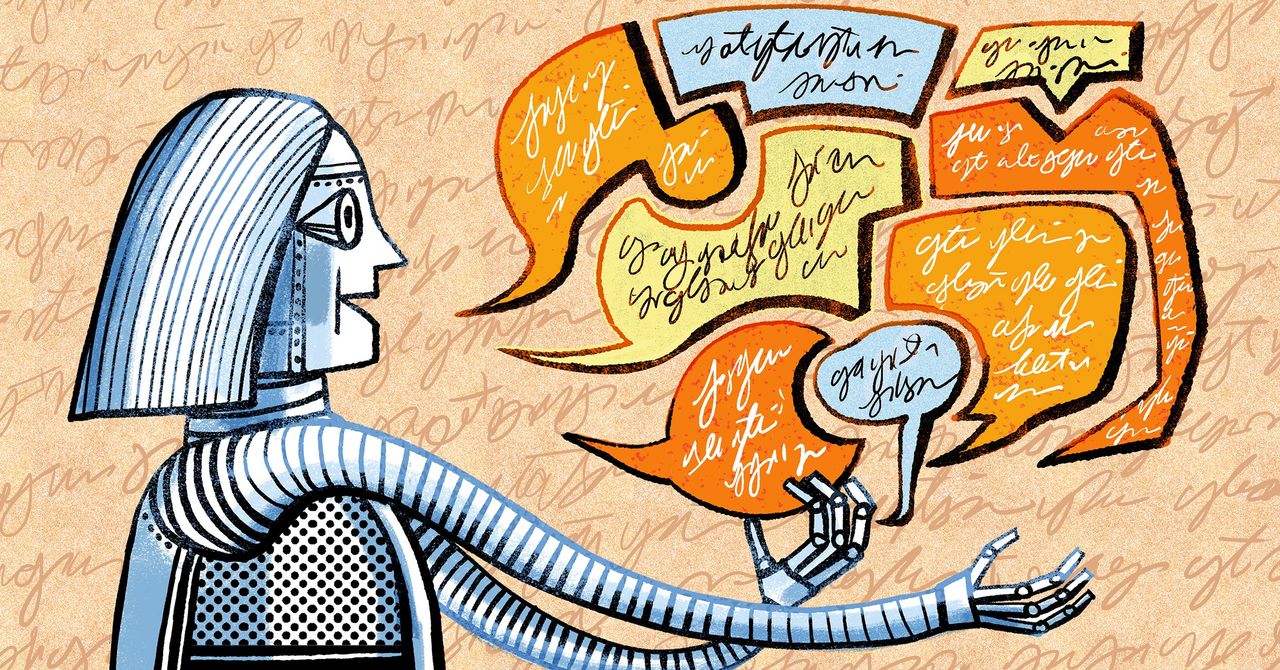Tech
The Free Ride for EVs in the Carpool Lane Is Coming to an End

A rough year for electric vehicle adoption just got a little rougher for owners in some parts of the US. Starting next month, EVs will no longer be able to ride in the fast lane in California, after the US federal government and Congress failed to reauthorize a popular program that has given hybrid and electric vehicles access to state carpool lanes—and worked to promote the sale of electrics for more than 25 years.
Under the program, California drivers with qualifying electric, plug-in hybrid, or hydrogen fuel cell vehicles could purchase $27 stickers that gave them access to several highway carpool lanes, plus discounts on a number of toll roads and bridges—even if a driver was alone in their car. Over 1 million decals have been issued to California drivers since the program’s start in 1999, and hundreds of thousands of vehicles have decals today.
However, those decals will no longer be valid after September 30, the California Department of Motor Vehicles said in a press release. Drivers who currently have stickers—even those who purchased them recently—won’t receive refunds, the department confirmed.
California isn’t alone. Another pilot project that gave some New York state electric-vehicle drivers access to carpool lanes will also end. Over 48,000 New Yorkers had received decals through that Clean Pass program.
The programs are ending because they were not reauthorized by the president and Congress, says Walter McClure, a spokesperson for the New York Department of Motor Vehicles. The White House did not respond to WIRED’s questions about why President Donald Trump chose not to reauthorize the program.
The end of the decal program is yet another knock back for US electric vehicles, which are facing long-term slower-than-projected sales in the country following a cut in government support for the newer car tech. EV-curious buyers have rushed to purchase new and used electric vehicles before tax credits, worth up to $7,500, end this month. But analysts expect that US sales will once again slow after the credit expires, even as the rest of the world continues its transition to EVs. Just a year ago, many analysts projected that between a quarter and a half of new US cars sold in 2030 would be electric; since then, those projections have been cut by half.
But while the California program’s end will likely frustrate plenty of EV drivers, it might not make a meaningful dent in the state’s transition to new-energy vehicles. The state has raced ahead of the rest of the country in EV adoption; 22 percent of new light-duty vehicles sold in the state so far this year have been battery-electric, plug-in hybrid, or hydrogen-powered, according to state data. Compare that to the projected 8 percent of new electrified vehicle sales for the rest of the country, and the reason for the program closure might become clearer—it seems the state’s carpool lanes were getting crowded.
The decal program “worked nicely as a bundle with monetary incentives,” says Gil Tal, the director of the Electric Vehicle Research Center at UC Davis, who has studied the effectiveness of the decal program over the past decade. “It was another reason to buy an electric car.”
Tech
PlayStation Portal’s Latest Update Proves Sony Needs a Real Handheld Console Again

Another year, another update to Sony’s PlayStation Portal. The latest tweak to the hardware considerably expands the roster of games playable on the device—but the end result only highlights how urgently PlayStation needs to re-enter the gaming handheld market for real.
The evolution of PlayStation Portal has been fascinating to watch, mainly to see Sony practically scrambling to keep up with the gadget’s unexpected popularity. Launched November 2023, Portal was intended as a mere accessory for PlayStation 5. It had no native processing abilities, simply using Sony’s Remote Play technology to stream whatever happened on players’ personal PS5 to the portable’s screen.
Although it could technically be used anywhere with a strong Wi-Fi signal, difficulties connecting to public networks and high speed requirements to even launch a stream meant the Portal was effectively only suitable for in-home use, to free up the main TV or play in another room.
Somehow, it still took off, with Sony Interactive Entertainment CEO Hideaki Nishino saying in 2024 that the Portal had been a “huge success.” The same year, Sony made it easier to connect to public Wi-Fi and added actual cloud gaming support to Portal, with a selection of games on offer to players subscribing to PlayStation Plus Premium. The initial offering included “over 120 PS5 games from the PS Plus Game Catalog,” though the curated library was subject to change. It could have been a big shift in how players approached hardware and software alike, but, in practice, didn’t really deliver.
Even so, another year on and the Portal’s success seems unstoppable. Sony’s Takuro Fushimi recently told TechRadar that “the community’s response has been overwhelming” and that Portal is now the “most widely used device for PS5 Remote Play.” It’s little surprise, then, that Sony keeps trying to hammer it into something that looks, if you squint, like the standalone gaming handheld it was never intended to be, but that players so desperately want.
Clearer Skies?
Enter the newest update to PlayStation Portal. It takes Cloud Streaming out of its beta phase, expanding the streamable library from only those titles included in the PS Plus selection to many games digitally owned by players. Until now, if you didn’t have a game installed locally on your PS5 or it wasn’t included in that cloud catalog, too bad, no Portal play for you. Going forwards, you’ll be able to cloud stream many titles if they’re tied to your PlayStation account through purchase on the PlayStation Store—although you will still need to be subscribed at the PS Plus Premium tier to use the feature, which will set you back $160 for a full year.
The assortment available is already vast—more than 3,000 games at time of writing. On the face of it, this should be a transformative development for not just the Portal, but PlayStation as a gaming ecosystem. It potentially extends availability of titles you own to wherever you want to play them, and could even help alleviate data storage woes. Although the PS5’s internal drives can be expanded, SSDs can be pricey at higher capacities, and players with large digital collections often can’t install everything they own. Being able to stream games tied to your account without eating up drive space could be a great workaround.
The update also aims to improve the broader player experience on Portal. It finally adds the ability to make in-game purchases when cloud streaming (potentially useful if you want to buy some DLC or virtual currency), and allows players to receive game invites to multiplayer sessions when playing a game via the cloud. Previously, these features were only enabled for Remote Play gaming on Portal, since they were effectively being done through the PS5 and mirrored on the Portal’s screen. Accessibility features have also been improved, adding a screen reader tool and adjustable text sizes.
Tech
For the First Time, AI Analyzes Language as Well as a Human Expert

The original version of this story appeared in Quanta Magazine.
Among the myriad abilities that humans possess, which ones are uniquely human? Language has been a top candidate at least since Aristotle, who wrote that humanity was “the animal that has language.” Even as large language models such as ChatGPT superficially replicate ordinary speech, researchers want to know if there are specific aspects of human language that simply have no parallels in the communication systems of other animals or artificially intelligent devices.
In particular, researchers have been exploring the extent to which language models can reason about language itself. For some in the linguistic community, language models not only don’t have reasoning abilities, they can’t. This view was summed up by Noam Chomsky, a prominent linguist, and two coauthors in 2023, when they wrote in The New York Times that “the correct explanations of language are complicated and cannot be learned just by marinating in big data.” AI models may be adept at using language, these researchers argued, but they’re not capable of analyzing language in a sophisticated way.
That view was challenged in a recent paper by Gašper Beguš, a linguist at the University of California, Berkeley; Maksymilian Dąbkowski, who recently received his doctorate in linguistics at Berkeley; and Ryan Rhodes of Rutgers University. The researchers put a number of large language models, or LLMs, through a gamut of linguistic tests—including, in one case, having the LLM generalize the rules of a made-up language. While most of the LLMs failed to parse linguistic rules in the way that humans are able to, one had impressive abilities that greatly exceeded expectations. It was able to analyze language in much the same way a graduate student in linguistics would—diagramming sentences, resolving multiple ambiguous meanings, and making use of complicated linguistic features such as recursion. This finding, Beguš said, “challenges our understanding of what AI can do.”
This new work is both timely and “very important,” said Tom McCoy, a computational linguist at Yale University who was not involved with the research. “As society becomes more dependent on this technology, it’s increasingly important to understand where it can succeed and where it can fail.” Linguistic analysis, he added, is the ideal test bed for evaluating the degree to which these language models can reason like humans.
Infinite Complexity
One challenge of giving language models a rigorous linguistic test is making sure they don’t already know the answers. These systems are typically trained on huge amounts of written information—not just the bulk of the internet, in dozens if not hundreds of languages, but also things like linguistics textbooks. The models could, in theory, simply memorize and regurgitate the information that they’ve been fed during training.
To avoid this, Beguš and his colleagues created a linguistic test in four parts. Three of the four parts involved asking the model to analyze specially crafted sentences using tree diagrams, which were first introduced in Chomsky’s landmark 1957 book, Syntactic Structures. These diagrams break sentences down into noun phrases and verb phrases and then further subdivide them into nouns, verbs, adjectives, adverbs, prepositions, conjunctions and so forth.
One part of the test focused on recursion—the ability to embed phrases within phrases. “The sky is blue” is a simple English sentence. “Jane said that the sky is blue” embeds the original sentence in a slightly more complex one. Importantly, this process of recursion can go on forever: “Maria wondered if Sam knew that Omar heard that Jane said that the sky is blue” is also a grammatically correct, if awkward, recursive sentence.
Tech
AMD CEO Lisa Su Isn’t Afraid of the Competition

Michael Calore: Recording works.
Lauren Goode: Recording. Yeah.
Michael Calore: Yeah. It’s like when people say, let me film that. You’re not actually filming anything. You’re shooting a digital video.
Lauren Goode: So then if you have a video podcast, are you shooting the podcast? What do you say? Do you say taping, then?
Michael Calore: I think you say recording because it just—
Lauren Goode: Recording the pod.
Michael Calore: Yeah.
Lauren Goode: We’re recording the pod.
Michael Calore: It covers all the bases.
Lauren Goode: We’re capturing it.
Michael Calore: That’s what we’re doing.
Lauren Goode: We’re sublimating it. All right. Well, should we record this pod?
Michael Calore: I would like to, yes.
Lauren Goode: Let’s do it.
Michael Calore: Honestly, I’m still recovering from last week’s Big Interview event. My throat is still feeling a little bit raw, even though it’s been like four or five days.
Lauren Goode: You sound delightful to me.
Michael Calore: Thank you.
Lauren Goode: But that really was an epic event.
Michael Calore: It was.
Lauren Goode: Yeah.
Michael Calore: You were on stage.
Lauren Goode: I was. I was first up in the morning. Katie, our boss, gave the intro to the conference and then it was me and Lisa Su, the CEO of AMD. And not only was it a really interesting conversation, but then I was done for the day. I didn’t have to do any more interviews after that. And I just got to listen and absorb, and there were some other really great talks.
Michael Calore: There were, yes. And we’re going to talk through some of them. We’re also going to listen to your conversation with Lisa Su, and then we’ll talk about it, and we’ll take listeners behind the scenes of The Big Interview.
-

 Politics6 days ago
Politics6 days agoThailand launches air strikes against Cambodian military: army
-

 Tech1 week ago
Tech1 week agoWIRED Roundup: DOGE Isn’t Dead, Facebook Dating Is Real, and Amazon’s AI Ambitions
-

 Sports1 week ago
Sports1 week agoAustralia take control of second Ashes Test | The Express Tribune
-

 Politics6 days ago
Politics6 days agoZelenskiy says Ukraine’s peace talks with US constructive but not easy
-

 Fashion6 days ago
Fashion6 days agoGermany’s LuxExperience appoints Francis Belin as new CEO of Mytheresa
-

 Politics1 week ago
Politics1 week ago17 found dead in migrant vessel off Crete: coastguard
-

 Business1 week ago
Business1 week agoNetflix to buy Warner Bros. film and streaming assets in $72 billion deal
-

 Politics3 days ago
Politics3 days agoTrump launches gold card programme for expedited visas with a $1m price tag

















